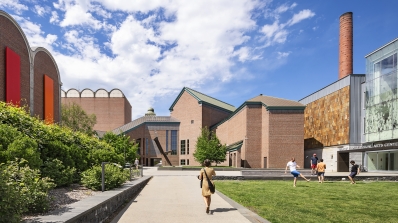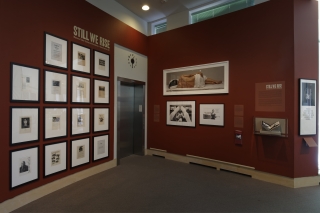Exhibitions Archive
Ukara cloth symbolizes the power, wealth, and prestige of the Ekpe secret society, an interethnic all-male association, and the sacrality of Ekpe meeting lodges. Although commissioned and used by the Ekpe, located in the Cross River region at the border of southeastern Nigeria and western Cameroon, ukara is designed, sewn, and dyed by the Ezillo people in present-day Ebonyi State. The process of creating ukara cloths is laborious and involves many hands, but ultimately each cloth is highly individualized, clearly produced to be worn by a specific Ekpe person or to mark a particular Ekpe lodge. Nsibidi symbols, an ideographic and gestural system of communication, are dyed onto the cloth. The symbols’ meanings are largely guarded by Ekpe members, with more established members becoming deeply knowledgeable about the poly-semantic signs.
Self-Portraiture in Contemporary Art
About FaceOrganized in collaboration with Studio Art majors from Dartmouth's Class of 2015, this exhibition explores the continued relevance and global diversity of self-portraiture in contemporary art. While self-portraiture has traditionally engaged with direct observation and autobiography, contemporary artists have begun to question the value and integrity of authorship and a coherent artistic identity through the use of disguise, impersonation, and assumed personae.
About Face explores the various approaches that contemporary artists have used to investigate identity as a culturally constructed phenomenon and will include works by such notable practitioners as Chuck Close, Susanna Coffey, Rineke Dijkstra, Marit Følstad, Nikki S. Lee, Sarah McEneaney, Nomusa Makhubu, Bruce Nauman, Wendy Red Star, Cindy Sherman, Kiki Smith, Christian Thompson, and Jeff Wall.
Sources of Abstraction
Gesture, Emotion, ShapeAbstraction comes from many different sources. It may begin with a concrete object, or something less tangible, such as an emotion or thought. Artists use abstraction to express that which cannot be conveyed through representation and to explore other sources of art-making. The works in the exhibition date from immediately after World War II until the present. Some were strongly influenced by abstract expressionism, and others stem from later movements, such as minimalism and conceptualism. This exhibition highlights three important sources of abstraction: gesture, emotion, and shape.
This exhibition was curated by Philip Dytko, Class of 2017, Pauline Lewis, Class of 2016, and Molly Siegel, Class of 2016, each of whom was enrolled in Professor Mary Coffey’s ARTH 71: The American Century. This course provides a thematic overview of American art in the twentieth century. Students in the class were placed into curatorial teams of three, and each team identified a theme, selected six objects from the permanent collection, drafted labels, and proposed an installation design for the exhibition. The teams presented their proposals to the entire class at the end of the term, and students voted on their favorite. Gesture, Emotion, Shape: Sources of Abstraction was the winning exhibition.

